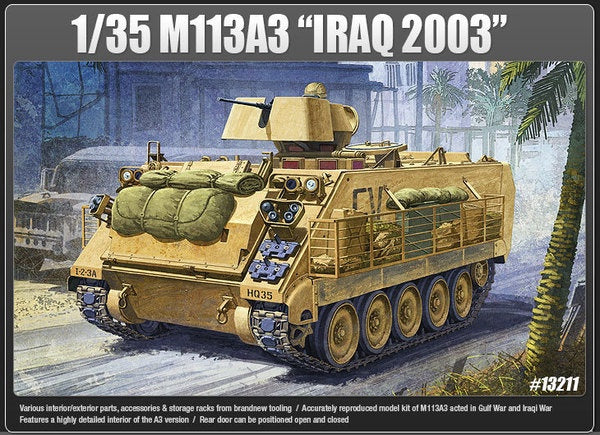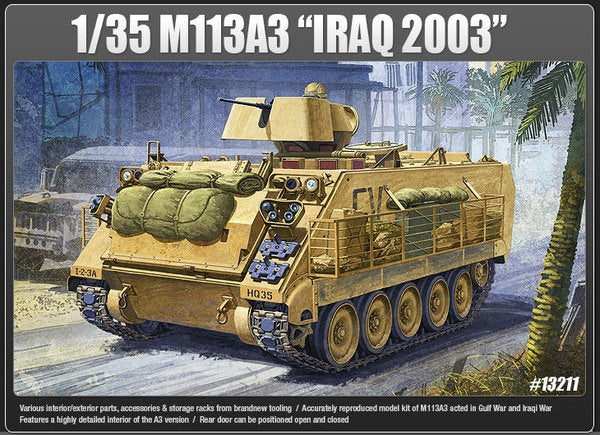*Clearance* Academy 1:35 M113A3 Iraq 2003 (LW)
*Clearance* Academy 1:35 M113A3 Iraq 2003 (LW) is backordered and will ship as soon as it is back in stock.
Couldn't load pickup availability
Delivery and Shipping
Delivery and Shipping
We use tracked courier for fast delivery New Zealand wide
Description
Description
The M113 is an American armored personnel carrier. The first designs were created in 1956, and serial production at FMC started in 1960. It lasted until 1987 and resulted in the production of 73,000 copies of this vehicle for the US Army's own needs as well as for export. The M113 entered service in as many as 45 countries, including Israel, Spain, Italy, Greece and Germany. The M113 is the most popular transport in the world and forms the basis for the world's largest family of armored vehicles. The M113 hull is constructed of steel and aluminum, with welded armor. This lowers the weight, but protects the crew only against small caliber ammunition. The Israeli army uses Rafael TOGA armor to correct this shortcoming. The driving position is located at the front left and the engine at the front right of the vehicle. Landing soldiers (up to 7 people) sit on benches along the hull and start the fight via the ramp located at the back of the transporter, which is hydraulically lowered. The basic M113 is able to overcome water obstacles, driven by tracks. The M113 was involved in a very large number of conflicts among others. in the Vietnam War, in the Yom Kippur War, in Operation Desert Storm, and in the 2003 Iraq War. In the US Army, it is systematically replaced by the M2 Bradley car. Among the huge family based on the M113 chassis, one can mention the American M901, which is armed with a TOW launcher, or the Israeli M113 Fitter with a special crane mounted, which is the basic vehicle of the Israeli repair and repair services in armored battalions. Fitter is also used by Australia and Belgium. Technical data (version M113A3): length: 4.86m, width: 2.69m, height: 2.54m, weight 12.1t, engine power: 266KM, speed (on the road): 66km / h, armament: 1 machine gun 12.7mm caliber.
Second Persian Gulf War 2003 invasion of Iraq ) was formally launched on March 19, 2003, and formally ended with a speech by US President George W. Bush Jr. on May 1, 2003. It is worth remembering, however, that American troops and the countries supporting them officially remained in Iraq until 2011. The main cause of the conflict was the US's desire to destroy the weapons of mass destruction allegedly owned by Iraq, and the country's alleged sponsorship of international terrorism - a slogan that was particularly popular and important for the US citizen after the tragic attack of September 11, 2001. On one side of the barricade, in the course of this war, stood the troops of the anti-Iraqi coalition composed of the forces of several countries (including Poland), but mainly of the United States, which in the period March-April 2003 totaled approx. 200,000. Over time, the numbers of these forces changed. Their opponent was the Iraqi forces estimated at 350,000-380,000 soldiers. Paradoxically, then, the Iraqi forces had an advantage in numbers, but they were clearly inferior to the coalition forces on other levels of the art of war. Contrary to the First Gulf War, the command of the coalition forces decided to conduct simultaneous very intensive operations on land and in the air, focusing primarily on the technological advancement of its own forces, surprise and speed of action. The main goal of the operation was to seize Baghdad as a result of a violent raid of coalition troops deep into Iraq. It is worth adding that in the course of this highly movement phase of the war, the coalition's troops bypassed larger cities, making an exception for the important cities of Basra. Within 21 days of the start of the attack, the coalition's troops had reached Baghdad, and on April 9, 2003, the capital of Iraq was formally in the hands of the coalition forces. Considering the war from a purely military point of view, it ended with a complete success of the coalition forces, achieved very quickly and with minimal losses. From a political point of view, however, it turned out to be a debatable victory, and what's more, it engaged American troops in long-term stabilization activities in Iraq, the cost of which - both human and economic - probably exceeded the costs of the March-April 2003 operation.
1:35 scale plastic assembly kit. Requires glue and paints to complete.
Payment & Security
Payment methods
Your payment information is processed securely. We do not store credit card details nor have access to your credit card information.




